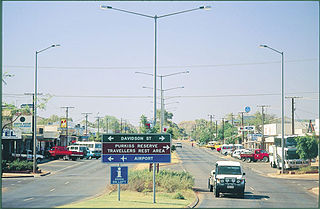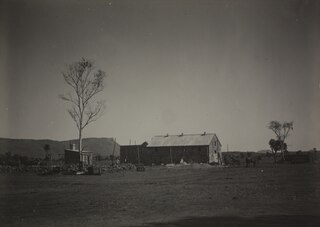
Ian Lindsay Tuxworth was an Australian politician, who was Chief Minister of the Northern Territory of Australia from 17 October 1984 until his resignation on 10 May 1986.

Tennant Creek is a town located in the Northern Territory of Australia. It is the seventh largest town in the Northern Territory, and is located on the Stuart Highway, just south of the intersection with the western terminus of the Barkly Highway. At the 2021 census, Tennant Creek had a population of 3,080 people, of which 55% (1,707) identified themselves as Indigenous.

The NORFORCE is an infantry regiment of the Australian Army Reserve. Formed in 1981, the regiment is one of three Regional Force Surveillance Units (RFSUs) employed in surveillance and reconnaissance of the remote areas of Northern Australia. It consists of a regimental headquarters, four surveillance squadrons, and an operational support squadron and training squadron.
Barkly is an electoral division of the Legislative Assembly in Australia's Northern Territory. It was first created in 1974, and is named after the Barkly Tableland area, which occupies much of the electorate. Barkly is a rural electorate, covering 442,868 km² and taking in the towns of Tennant Creek, Borroloola, Ali Curung, Warrego, Tara Aboriginal Community and Alpururulam. There were 5,690 people enrolled in the electorate as of August 2020.

A general election was held in the Northern Territory, Australia on Saturday 7 March 1987. Although the incumbent Country Liberal Party (CLP) won a majority under new leader Stephen Hatton, the party's vote was down almost 20 percentage points.

Lake Mary Ann or Tingkkarli, previously known as Mary Ann Dam is situated about 5 kilometres (3.1 mi) north of Tennant Creek, Northern Territory, Australia, just off the Stuart Highway. It is a man-made dam where some water sports can be conducted such as swimming or canoeing, surrounded by landscaped grassy areas on one side and natural bushland on the other.

Fenton Airfield was a World War II military airfield in the Northern Territory of Australia located at Tipperary Station in what is now the locality of Douglas-Daly and named after flight lieutenant Clyde Fenton.
Long Airfield was a World War II military airfield located in the locality of Douglas-Daly, Northern Territory, Australia.
Elliott is a town in Northern Territory of Australia. It is almost halfway between Darwin and Alice Springs on the Stuart Highway. The town is in the Yapurkulangu ward of the Barkly Region. At the 2016 census, Elliott had a population of 339.
Timber Creek, traditionally known as Makalamayi, is an isolated small town on the banks of the Victoria River in the Northern Territory of Australia. The Victoria Highway passes through the town, which is the only significant settlement between the Western Australia border and the town of Katherine to the east. Timber Creek is approximately 600 kilometres (370 mi) south of Darwin, in an area known for its scenic escarpments and boab trees.

Adelaide River railway station is a former railway station on the now-closed narrow-gauge North Australia Railway, in the Northern Territory, Australia, 124 kilometres south of the Darwin terminus of the line. Now a museum with exhibits that include buildings, rolling stock and memorabilia, it is located on the main north–south road route through the Northern Territory, the Stuart Highway. It was one of the most significant stations on the line; the only station with a refreshment room. Former Commonwealth Railways diesel locomotive NSU 63 is displayed between the highway and the station.
Connells Lagoon Conservation Reserve also known as Dalgajini is a protected area in the Northern Territory of Australia.

The Alice Springs Telegraph Station is located within the Alice Springs Telegraph Station Historical Reserve, four kilometres north of the Alice Springs town centre in the Northern Territory of Australia. Established in 1872 to relay messages between Darwin and Adelaide, it is the original site of the first European settlement in central Australia. It was one of twelve stations along the Overland Telegraph Line.

Lyons Cottage, as so known as British Australian Telegraph Company Residence, is one of the oldest remaining heritage buildings in the central business district in Darwin City in the Northern Territory of Australia.

The Tennant Creek Telegraph Station is an historical site about 16 kilometres north of Tennant Creek in the Northern Territory of Australia.

The Church of Christ the King is located in Tennant Creek in the Northern Territory of Australia. The church was relocated from the historic mining town of Pine Creek. With parts of the church spread between the two towns during the move, it was once known as the "longest church in Australia".

Nobles Nob mine is a gold mine in the Northern Territory of Australia located in the locality of Warumunga about 13 kilometres (8.1 mi) south-east of the town of Tennant Creek. It was once the richest gold mine for its size in the world.

William Henry Charles Fullwood, better known as Bill Fullwood, was an Australian painter. He is considered one of the most significant artists from the Barkly region of the Northern Territory of Australia, best known for his depictions of scenes of the Barkly region. He was a long-term resident and mining pioneer of Tennant Creek. The historic Tuxworth Fullwood House is named after him.
Ali Curung is an Indigenous Australian community in the Barkly Region of the Northern Territory. The community is located 170 km (106 mi) south of Tennant Creek, and 378 km (235 mi) north of Alice Springs. At the 2021 census, the community had a population of 394.

Stuart Town Gaol in Alice Springs, Northern Territory, Australia, located on 9 Parson Street, was constructed in 1907, when Alice Springs had a European population of approximately 30 people, and held its first prisoner in 1909. It is one of the earliest permanent buildings constructed in the town and the first government building. The gaol follows a simple design and was built, using local materials, by stonemason Jack Williams.















